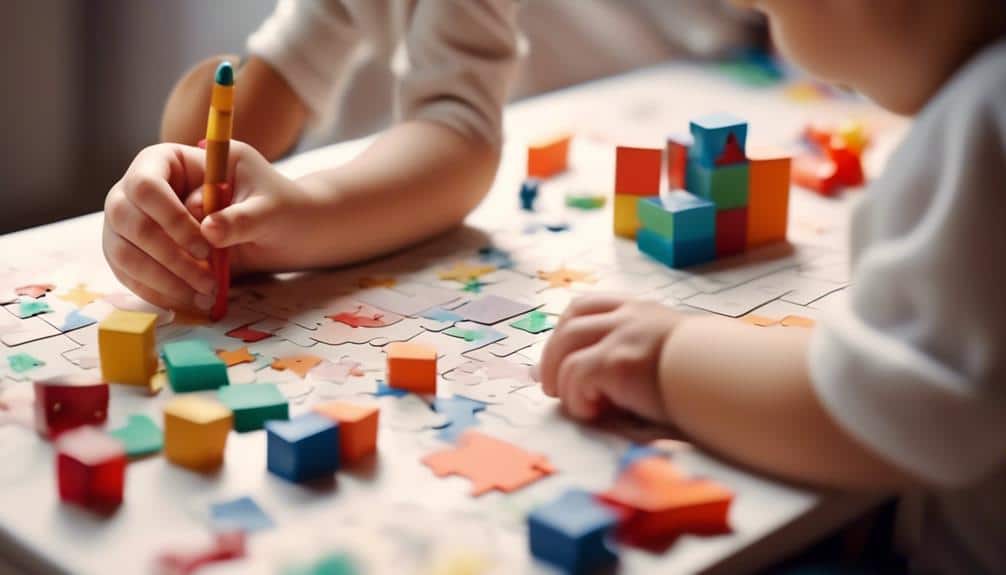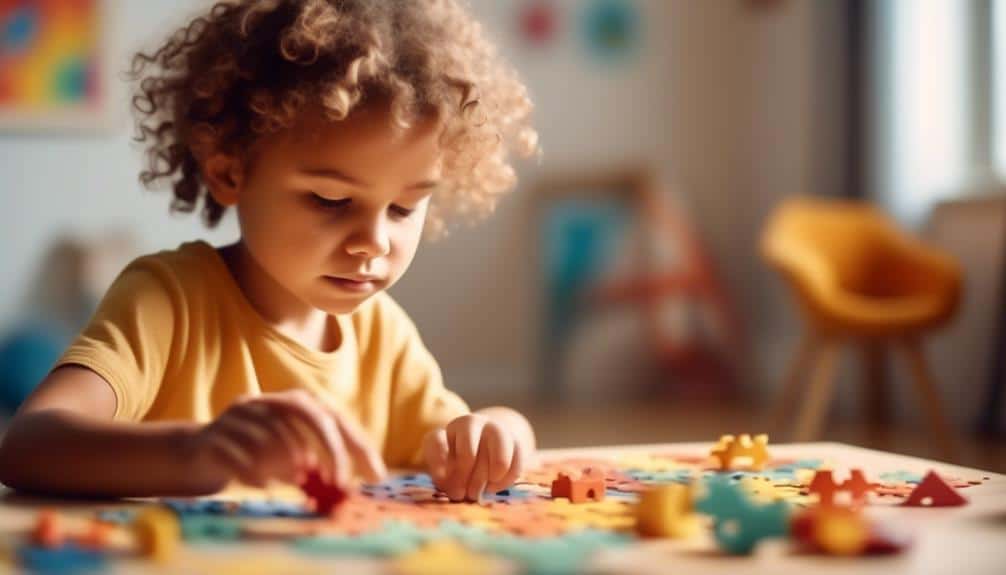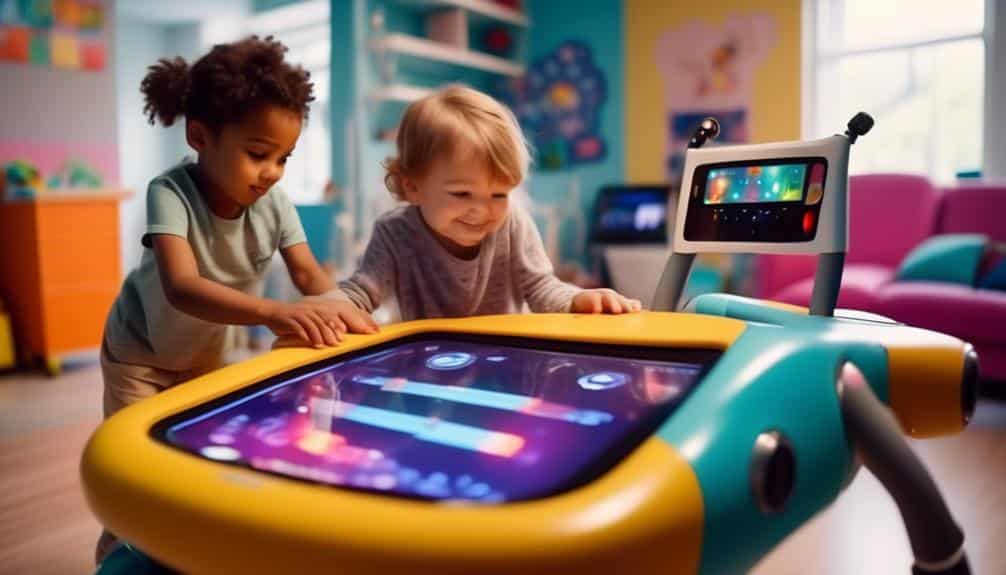The journey of developing motor skills in children is vital for their growth and independence. In pediatric care, we think of twelve standout therapies, such as these Motor Skill Marvels, crafted to assist children facing developmental challenges or physical hurdles. From Sensory Integration Therapy, aiding sensory processing, to Neurodevelopmental Treatment, enhancing posture and movement, each therapy uniquely contributes to improving a child’s motor abilities.
When strategically incorporated, these therapies can significantly impact a child’s navigation and interaction with their surroundings. Parents and educators dealing with children struggling with fine motor skills must consider how Motor Skill Marvels can be seamlessly integrated into personalized care plans. By understanding the nuances and outcomes of these therapies, we can unlock their potential to shape the trajectories of children’s lives.
Let’s delve into the layers and collaborative efforts that underline the success of Motor Skill Marvels, paving the way for enhanced motor skills and overall well-being in children.
Key Takeaways
- Sensory integration therapy, NDT, and other pediatric therapies can assist children with sensory processing disorders in processing and responding to sensory stimuli.
- Occupational therapists create individualized plans based on each child’s needs and abilities to address sensory needs and improve motor skills.
- Constraint-induced movement therapy (CIMT) can enhance the use of affected limbs by restricting the unaffected ones and promoting neuroplastic changes.
- Aquatic therapy techniques, such as water resistance, can enhance muscle strength, support overall developmental progress, and aid sensory processing.
Sensory Integration Therapy
Sensory Integration Therapy is a specialized approach designed to assist children in better processing and responding to the multitude of sensory stimuli they encounter daily. This form of Pediatric Therapy is integral for children who struggle with Sensory Processing disorders, including those diagnosed with autism, ADHD, and other developmental challenges. Through personalized therapeutic activities, such as swinging, brushing, and tactile experiences, children learn to regulate their sensory input, which can improve motor skills and help them reach critical developmental milestones.
Occupational therapists trained in sensory integration therapy craft individualized plans that address the unique sensory needs of each child. These plans aim to create a just-right challenge—enough to engage the child but not so much as to cause undue stress. The goal is to facilitate a child’s ability to process sensory information more effectively, which is critical to their learning and everyday functioning. By doing so, occupational therapy helps children navigate their environments more efficiently, contributing to their overall developmental progress and enhancing their quality of life.
Neurodevelopmental Treatment
Neurodevelopmental Treatment (NDT) represents a cornerstone approach in pediatric therapy, aiming to establish functional motor patterns in children with developmental challenges. This therapeutic strategy employs tailored handling techniques, activities, and environmental adaptations to enhance a child’s postural control and coordination incrementally. By integrating principles of NDT, therapists work to fortify motor control, ensuring that each intervention is seamlessly woven into the child’s daily life for maximum efficacy.
Principles of Neurodevelopmental Therapy
Understanding the principles of Neurodevelopmental Therapy is crucial in addressing the unique motor development challenges children with movement disorders face. This approach, guided by pediatric physical therapists, is instrumental in enhancing a child’s development of gross and fine motor skills. Neurodevelopmental therapy provides a structured framework for overcoming motor skill difficulties and nurturing the child’s ability to engage with their environment effectively.
- Neurodevelopmental Therapy Principles:
- Promotes normal movement patterns
- Facilitates postural control and functional movement
- Uses critical points of control for optimal motor patterns
- Individualized to the child’s needs and abilities
- Implementation in Therapy:
- Integrates sensory, cognitive, and motor components
- Tailored hands-on techniques and activities
- An empathetic approach to each child’s unique challenges
This empathetic, precision-driven method fosters meaningful progress and empowerment in children’s motor skill development.
Enhancing Motor Control
Building upon the foundational principles of neurodevelopmental therapy, enhancing motor control is a pivotal aspect of pediatric intervention for improving movement patterns and functional abilities in children with motor skill deficits. Neurodevelopmental Treatment (NDT) is a specialized practice that enhances gross and fine motor skills through individualized therapeutic strategies. These interventions, empathetically designed, are aimed at promoting a child’s fine motor precision and the development of gross motor abilities by improving postural control, balance, and coordination.
NDT facilitates natural movement patterns crucial for fine motor skill development and overall motor control enhancement by emphasizing the child’s active participation in functional activities.
| Aspect of NDT | Focus Area | Outcome |
|---|---|---|
| Handling Techniques | Postural Control | Improved Stability |
| Positioning | Balance and Coordination | Enhanced Movement |
| Task-Specific Activities | Functional Abilities | Active Participation |
NDT in Practice
Implementing NDT in pediatric therapy entails a comprehensive approach that fosters standard movement patterns and encourages active engagement in children with motor skill challenges. This method is crucial in pediatric physical therapy, particularly for children experiencing developmental delays. Its application is instrumental in early intervention strategies to enhance motor skills development.
- Holistic and Individualized Approach:
- Collaborative effort between therapists, caregivers, and children
- Personalized therapy plans to address daily life motor challenges
- Techniques Used in NDT:
- Handling and facilitation to guide movement
- Environmental adaptations to promote functional independence
Neurodevelopmental Treatment (NDT) is not just a set of techniques; it is a philosophy of care that integrates the child’s goals and capabilities into every therapeutic interaction, striving for a seamless integration into the child’s daily life.
Constraint-Induced Movement Therapy
Constraint-Induced Movement Therapy (CIMT) is a vital intervention designed to enhance the use of a child’s affected limb by restricting the unaffected one, thereby encouraging intensive practice and use of the weaker extremity. The duration and intensity of CIMT are critical variables tailored to each child’s unique needs to maximize neuroplastic changes and functional improvements in their daily activities. Careful consideration of these factors by a collaborative team of healthcare professionals can significantly improve a child’s motor skill development and overall quality of life.
Enhancing Affected Limb Use
Harnessing the brain’s remarkable capacity for adaptation, Constraint-Induced Movement Therapy (CIMT) transforms the limitations of an affected limb into opportunities for empowerment and motor skill development in pediatric patients. By emphasizing affected limb use, this therapy guides children through:
- Intensive, repetitive practice
- *Promotes neuroplastic changes*
- *Improves fine motor skills*
- Task-oriented exercises
- *Enhances hand function and coordination*
- *Builds strength in the affected limb*
Occupational therapists apply CIMT with empathy and precision, focusing on each child’s unique potential to overcome challenges. The aim is to foster a supportive environment where pediatric patients can experience incremental victories, leading to greater independence and confidence in their daily activities. Through dedicated application, CIMT helps unlock the latent capabilities of young individuals, catering to those committed to serving and nurturing growth.
Therapy Duration and Intensity
Building on the foundational principles of enhancing limb use through Constraint-Induced Movement Therapy, the subsequent phase focuses on the specific therapy duration and intensity parameters to optimize motor skill development in pediatric patients. For children, particularly those with cerebral palsy, achieving developmental milestones is paramount, and CIMT offers a structured approach to improving motor skills. Sessions are conducted for several hours daily, spanning two to four weeks, integrating high-intensity activities crucial for eliciting neuroplasticity. This concentrated approach requires significant commitment, as the child and caregivers must dedicate time to rigorous physical activity. Such dedication is essential for the therapy’s success, as it ensures maximum impact within a short but potent timeframe, fostering essential motor skill growth and development.
Aquatic Therapy Techniques

Through the application of aquatic therapy techniques, children experience an engaging environment that promotes the development of motor skills by leveraging the physical properties of water. The immersion in aquatic settings not only fosters improvement in gross motor skills but also supports overall developmental progress and physical health in a fun and dynamic way.
Aquatic therapy is distinguished by several core techniques that capitalize on water’s natural features:
- Resistance & Strength
- Water resistance enhances muscle strength as children move against the force of the water, performing activities like walking, reaching, or kicking.
- This resistance is essential for developing coordination and gross motor skills.
- Buoyancy & Balance
- The buoyancy of water supports the body, reduces the fear of falling, and allows for freedom of movement, making it easier to practice balance and stability exercises.
- Children can engage in weight-bearing activities with less strain, which is particularly helpful for those with physical limitations.
The sensory-rich environment provided by aquatic therapy also aids in sensory processing, offering a therapeutic space for children with sensory integration challenges. With each guided session, therapists aim to enhance the child’s confidence and autonomy while making strides in their developmental journey.
Hippotherapy for Coordination
While aquatic therapy utilizes the unique properties of water to enhance motor skills, hippotherapy offers a different but equally beneficial approach by incorporating horseback riding to improve coordination in children. This form of therapy is not about horseback riding per se. Still instead, it uses the rhythmic, repetitive movements of the horse as a therapeutic tool to foster a child’s gross motor development.
In pediatric therapy, the dynamic and three-dimensional movements of a horse’s pelvis during a ride closely mimic human gait, which is instrumental in enhancing a child’s coordination and postural control. The sensory input gained through hippotherapy is multifaceted, providing a rich experience that can lead to improved body awareness and spatial orientation.
Visual-Motor Integration Support

Understanding and improving visual-motor integration is crucial, as this skill allows children to synchronize their visual perception with their motor actions, facilitating essential tasks such as writing, drawing, and playing sports.
- Visual-motor integration support can significantly enhance a child’s ability to perform in academic settings and beyond by:
- Strengthening the hand-eye coordination needed for precise movements.
- Fostering the development of fine motor skills that are foundational for educational success.
With early intervention and targeted occupational therapy interventions, visual-motor integration challenges can be addressed proactively, contributing to a child’s gross developmental milestones and learning abilities.
- Occupational therapy, a core component in visual-motor integration support, employs activities that:
- They aThey are tailored to each child’s needs, considering their unique developmental stage.
- Engage children in enjoyable and therapeutic exercises designed to improve their visual-motor coordination.
Professionals dedicated to serving children understand the importance of visual-motor integration support in promoting motor skills and overall development. Their empathetic and precise approach ensures that each child receives the individualized care needed to overcome barriers to their motor skill growth.
Play-Based Therapy Approaches
Building upon the foundation of visual-motor integration, the DIRFloortime model offers a dynamic and engaging approach to enhancing motor skills in children. This model centers around activities tailored to the child’s needs, making therapy enjoyable and productive. Children actively participate by incorporating the DIRFloortime model into the therapeutic process, improving their motor skills in a natural and pleasant setting.
Tailoring DIRFloortime interventions to a child’s specific needs fosters targeted development in areas of motor skill deficits. Through engagement with toys, games, and creative activities, children learn and practice motor skills and build confidence and a sense of achievement. These DIRFloortime-based therapy approaches exemplify how therapeutic practices can be engaging and specific, ensuring that each child’s journey toward motor skill growth is supported compassionately and effectively.
Below is an overview of the DIRFloortime method of therapy approaches:
| Engagement Type | Targeted Skill | Example Activities |
|---|---|---|
| Games | Fine Motor | Puzzles, threading |
| Creative Play | Gross Motor | Obstacle courses |
| Sensory Play | Sensory Motor | Sand and water play |
| Pretend Play | Cognitive Motor | Role-playing games |
 These DIRFloortime model-driven, child-led therapy approaches showcase how therapeutic practices can be both engaging and tailored, guaranteeing compassionate and practical support for every child’s path toward motor skill growth.
These DIRFloortime model-driven, child-led therapy approaches showcase how therapeutic practices can be both engaging and tailored, guaranteeing compassionate and practical support for every child’s path toward motor skill growth.
Cognitive Orientation to Daily Tasks
Transitioning from play-based methods, Cognitive Orientation to Daily Tasks (CO-OP) offers a structured program that emphasizes the mastery of motor skills through strategic cognitive engagement. By defining task strategies, CO-OP enables children to dissect complex tasks into achievable steps, fostering enhanced executive functions crucial for task management and problem-solving. This approach augments motor skill proficiency and nurtures a child’s independent learning and self-improvement capacity.
Defining Task Strategies
Defining Task Strategies, commonly known as Cognitive Orientation to Daily Tasks, is an intervention method that deconstructs complex activities into smaller, more manageable components, facilitating a child’s cognitive engagement and mastery of everyday tasks. This approach is particularly beneficial for children who are working towards achieving their developmental milestones in motor skills, both fine and gross.
- By fostering an environment where children can:
- Plan: Envision the required steps for an activity.
- Organize: Arrange these steps in an efficient sequence.
- And execute tasks with:
- Precision: Carry out each step with focused attention.
- Confidence: Build self-assurance in their abilities.
These therapeutic activities are designed to empower children, enhancing their motor skills and academic and social competencies.
Enhancing Executive Functions
Enhancing executive functions in children through Cognitive Orientation to Daily Tasks encompasses a series of structured interventions aimed at refining their ability to plan, organize, and execute tasks with adeptness. Cognitive training activities, such as memory games and problem-solving exercises, are foundational in strengthening these skills. By providing a consistent routine and precise schedules, we help improve your child’s cognitive organization and time management capabilities, which are essential for any child’s age. Encouraging children to self-monitor and evaluate their performance fosters cognitive flexibility and adaptive thinking, pivotal for their motor skill development. Furthermore, involving children in decision-making and goal-setting reinforces their executive functions, equipping them to navigate and manage daily tasks with increased proficiency.
Fine Motor Skill Strengthening
Fine motor skills are crucial for children’s development, as they lay the foundation for everyday activities, from self-care to academic tasks. Fine motor skill strengthening focuses on enhancing the coordination and agility of the hands and fingers, which is pivotal for your child’s strength and precision in performing daily functions.
- Critical Approaches to Fine Motor Skill Strengthening:
- Encouraging self-care routines that involve buttoning clothes and tying shoelaces can foster independence while strengthening fine motor skills.
- Integrating play-based activities that require the manipulation of small objects can make skill development enjoyable and engaging for children.
Occupational therapy is one of the primary treatment methods that can help your child with fine motor skill deficits. Therapists design customized interventions that target specific areas of need and resonate with your child’s interests and capabilities. Such therapies may include:
- Specific Exercises and Techniques:
- Using scissors and tweezers in structured tasks improves hand-eye coordination and grasp control.
- It employs handwriting exercises that promote proper grip and pressure, which is essential for academic success.
Handwriting Interventions

Building upon the foundation of fine motor skill strengthening, handwriting interventions offer targeted strategies to refine further a child’s writing ability legibly and efficiently. These interventions are crafted to improve your child’s fine motor skills and are specific to a child’s ability level, ensuring that every exercise is challenging and achievable. By fostering an environment that promotes growth, we enable children to gain confidence in their writing abilities.
Handwriting interventions are not one-size-fits-all; they should be individualized to address the unique needs of each child. This personalized approach ensures that interventions are more effective, as they cater to the specific challenges a child may face with their handwriting. Here’s a breakdown of some focused interventions:
| Strategy | Purpose |
|---|---|
| Pencil Grip and Posture | To enhance the physical mechanics of writing |
| Fine Motor Control | To strengthen the minute movements of the hand |
| Sensory-Motor Activities | To improve tactile feedback and coordination |
| Tailored Exercises | To address individual challenges and progress |
An empathetic understanding of the child’s current motor skills is essential, as is a precise method of developing these skills through practice and repetition. When implemented effectively, handwriting interventions can significantly improve a child’s writing, supporting their overall educational development.
Bilateral Coordination Activities
Bilateral coordination activities, integral to developing symmetrical body movement, lay the groundwork for a child’s improved hand-eye coordination, balance, and overall motor skill refinement. These crucial exercises engage both sides of the body in harmony, which is essential for enhancing fine and gross motor skills. Children utilize large muscles by participating in these activities, fostering greater body awareness and coordination.
Incorporating bilateral coordination activities into a child’s daily routine can be enjoyable and beneficial. Here are some structured ways to include these activities:
- Playful Engagement
- *Clapping games:* Encourage rhythm and coordination
- *Jumping jacks:* Combine fun with gross motor skill development
- Routine Incorporation
- *Playing catch:* Enhance hand-eye coordination in a social setting
- *Simultaneous limb movements:* Such as touching opposite toes to promote body awareness
These activities support motor skills development and increase a child’s confidence and independence in physical tasks. Caregivers and educators must foster an environment where bilateral coordination activities are a regular and enjoyable part of a child’s growth journey.
Assistive Technology Utilization

While bilateral coordination activities are foundational for motor skill development, assistive technology provides crucial support by adapting to children with motor skill challenges’ unique needs. Assistive technology utilization in pediatric therapies is not merely about giving devices; it’s a pathway to empowerment, enabling children to accomplish tasks that might otherwise be out of reach. This tailored support can significantly enhance a child’s skill set, particularly in gross motor skills, and foster a greater sense of independence.
Caregivers and therapists must work collaboratively to assess each child’s needs, choosing technology that aligns with their specific motor skill goals. The table below illustrates the variety of assistive technology options available to support motor skill growth in children:
| Type of Assistive Technology | Purpose |
|---|---|
| Specialized Seating | Supports proper posture and stability for enhanced motor control |
| Mobility Devices | Enables independent movement, facilitating exploration and interaction |
| Communication Aids | Allows non-verbal children to express needs, aiding in social motor skills |
Assistive technology utilization is a cornerstone of modern pediatric therapies. It provides children with the tools to navigate their environment more effectively, participate in educational and play activities, and ultimately improve their quality of life.
Frequently Asked Questions
What Motor Skill Marvels is most focused on Fine Motor Skills?
Motor Skill Marvels prioritizes Fine Motor Skills, employing targeted interventions like scissor exercises and handwriting activities to enhance children’s hand and finger coordination for everyday tasks and academic success.
What Are 3 Ways to Encourage Children’s Development in Small Motor Skills?
Three methods to foster small motor skill development in children include offering drawing and cutting activities, engaging in hand-eye coordination games, and providing tools like tweezers for acceptable motor practice.
What Are the 3 Key Areas of Physical Motor Development in Childcare?
How do we best nurture a child’s potential? The three critical areas of physical motor development in childcare are gross motor, fine motor, and visual-motor skills, each vital to a child’s growth.
What Are 5 Strategies or Activities for Enhancing Improving Physical and Motor Development in Children Ages 4 and 5?
To enhance physical and motor development in 4-5-year-olds, consider activities like obstacle courses, dance, interactive games, playground play, and crafting, which promote coordination, balance, fine motor skills, and overall physical health.
Conclusion
Pediatric occupational therapy is a crucial step for children with delicate motor skill issues, such as cerebral palsy, autism spectrum disorder, or restrictive food intake disorder. The therapy is conducted by a team of medical professionals who can help enhance the child’s motor and cognitive performance levels. The initial consultation involves an intake review of the child’s nutritional and age-appropriate food intake. This helps to create a tailored plan for the child’s nutritional intake, ensuring that the child grows physically and mentally.
The National Research Council, United States, and Cambridge University Press have published journals and research papers highlighting the importance of physical therapy in enhancing children’s learning and sport-specific technical skills. The Journal of Personality and Social Psychology, Journal of the Learning Sciences, Review of Educational Research, Psychological Review, Educational Psychology Review, and PLoS One have published articles that emphasize the role of pediatric physical therapy in enhancing cognitive performance.
Neither pediatric occupational nor pediatric physical therapy is restricted to traditional physical therapy, including massage therapy. The National Academies Press, Academic Press, and Oxford University Press have published studies highlighting the importance of massage therapy in enhancing children’s cognitive and physical performance.
In conclusion, pediatric Occupational or Physical therapy is crucial for children with delicate motor skill issues. It enhances cognitive and physical performance levels by reviewing the child’s intake, creating a tailored plan for nutritional intake, and providing age-appropriate food intake. Medical professionals conduct the therapy, including traditional physical therapy and massage therapy. Parents and teachers can rest assured that this therapy can help children reach their full potential.


Recent Comments